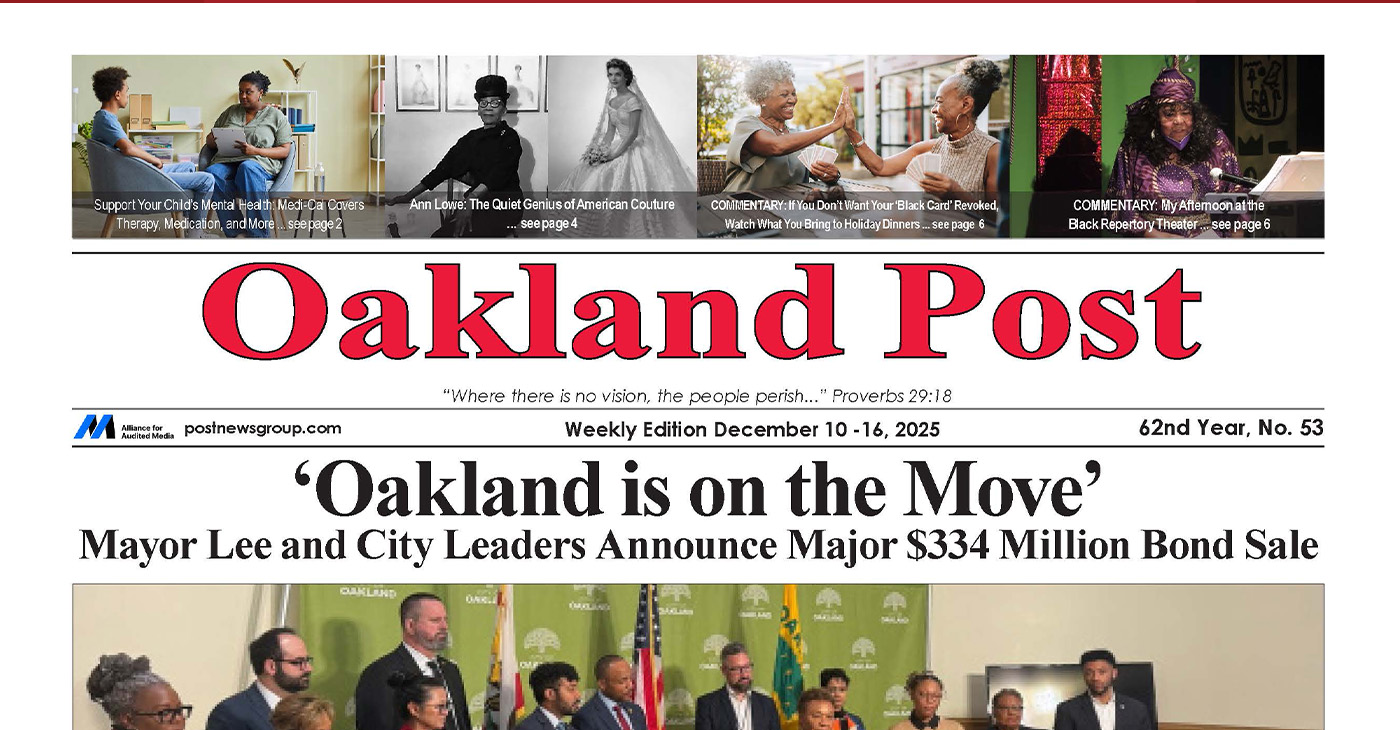Community
Latinos Significantly Underrepresented in Teaching and Other Jobs in OUSD
While Latino youth make up 41 percent and still growing numbers of students in the Oakland Unified School District (OUSD), they are a disproportionately small part of the OUSD workforce, significantly in the classroom, where only 13 percent of the district’s 2,120 teachers are Latino or Hispanic.
A number of Latino high school students and graduates report that they never had a Latino teacher during the years they attended school in the district.
Latino workers are significantly underrepresented in almost every major job classification. The numbers, which were released by the school district to the Latino Education Network (LEN) in September 2014, are stark.
Among 240 custodial services workers, 7.5 percent are Latino; 125 principals, assistant principals and child center administrators, 21.6 percent; 105 members of the staff of the OUSD police department, 10 percent; 130 food preparers and others in nutrition services, 9.4 percent; and 864 teachers, aides and other staff in special education, 10.3 percent.
Among the reasons that these statistics are important is that students need role models they recognize and the ability of teachers and other school staff to deeply understand the needs, family lives and culture of students directly impact the success of children in schools, according to many educators.
Another reason is that the OUSD is the second largest employer in Oakland with 7,664 employees, and its hiring and contracting policies are important to everyone who lives in the city. When the school district does not hire Latinos, it impacts workers and the educational futures of families of children who attend the schools.
According to Victor Martinez, LEN steering committee member, the district for years has claimed to be sympathetic about the need to increase the numbers of Latino teachers and other employers, but nothing changes.
“Latino groups have been raising issues for 40 years, and it seems we’re still in the same place,” he said. “We’re not interested in appeasement or window dressing. We’re interested in systemic change, institutional change,” he said.
Says Emma Roos, a LEN co-chair, “We continue to work with the district, through community advisory committees and finding areas where we can be of assistance.”
“We see small changes, new faces, but nothing dedicated to the urgent needs of Latino students,” she said.
Added LEN member and lifelong educator Jorge Lerma, “Though Latinos are large in number, things are done for us but without us. Latinos are not involved in designing and implementing and bringing their life issues into (educational programs).”
“The Latino community is significantly underrepresented in decision making, and that reflects in academics at the schools,” said Lerma.
Symptomatic and particularly upsetting, said Roos, is that the district has only 28 bilingual aides to help out in the classrooms, and only 14 are Spanish speaking. Roos is also concerned that the number of high achieving students who were honored at the OUSD annual Latino Honor Roll dropped this year after going up for several years in a row.
“We’re calling our status a state of emergency,” said Lerma. “They’re calling it ‘unrecognized bias,’ but it’s recognized by us.”
OUSD Supt. Antwan Wilson in a public statement pledged to work with Latinos to make changes. “To lift up and meet the needs of our growing Latino community, we have to embody the diversity of this community,” he said.
He said the district is working with the Unity Council’s Latino Men & Boys program “in eight of our schools serving over 200 young men and their families, providing academic support, male mentorship, and health and wellness programs, as well as career development and culturally-based activities.”
In an email to members of LEN, Brigitte Marshall, OUSD Chief Talent Officer, head of the human resources department, wrote about the efforts the district is taking to improve hiring of Latinos.
“Several months ago, I initiated a demographic comparative analysis of departmental staffing from which the demographic imbalance of various district departments could clearly be seen,” Marshall wrote.
“As a result of this, I have started the work of naming the issue with department leaders and working with them to develop strategies to improve their recruitment and hiring practices to ensure progress toward more representative staffing.
“We are challenged by the current limitations of our data tracking capabilities and recognize that the need to be able to demonstrate progress in hiring diversity rests in part in our ability to track the data correctly,” Marshall wrote.
Roos said she was glad the district was seeking to improve data collection, “But if legal, moral and educational issues are once again trumped by technical glitches, we are all lost.”
Activism
Oakland Post: Week of December 10 – 16, 2025
The printed Weekly Edition of the Oakland Post: Week of – December 10 – 16, 2025

To enlarge your view of this issue, use the slider, magnifying glass icon or full page icon in the lower right corner of the browser window.
Alameda County
Seth Curry Makes Impressive Debut with the Golden State Warriors
Seth looked comfortable in his new uniform, seamlessly fitting into the Warriors’ offensive and defensive system. He finished the night with an impressive 14 points, becoming one of the team’s top scorers for the game. Seth’s points came in a variety of ways – floaters, spot-up three-pointers, mid-range jumpers, and a handful of aggressive drives that kept the Oklahoma City Thunder defense on its heels.

By Y’Anad Burrell
Tuesday night was anything but ordinary for fans in San Francisco as Seth Curry made his highly anticipated debut as a new member of the Golden State Warriors. Seth didn’t disappoint, delivering a performance that not only showcased his scoring ability but also demonstrated his added value to the team.
At 35, the 12-year NBA veteran on Monday signed a contract to play with the Warriors for the rest of the season.
Seth looked comfortable in his new uniform, seamlessly fitting into the Warriors’ offensive and defensive system. He finished the night with an impressive 14 points, becoming one of the team’s top scorers for the game. Seth’s points came in a variety of ways – floaters, spot-up three-pointers, mid-range jumpers, and a handful of aggressive drives that kept the Oklahoma City Thunder defense on its heels.
One of the most memorable moments of the evening came before Seth even scored his first points. As he checked into the game, the Chase Center erupted into applause, with fans rising to their feet to give the newest Warrior a standing ovation.
The crowd’s reaction was a testament not only to Seth’s reputation as a sharpshooter but also to the excitement he brings to the Warriors. It was clear that fans quickly embraced Seth as one of their own, eager to see what he could bring to the team’s championship aspirations.
Warriors’ superstar Steph Curry – Seth’s brother – did not play due to an injury. One could only imagine what it would be like if the Curry brothers were on the court together. Magic in the making.
Seth’s debut proved to be a turning point for the Warriors. Not only did he contribute on the scoreboard, but he also brought a sense of confidence and composure to the floor.
While their loss last night, OKC 124 – GSW 112, Seth’s impact was a game-changer and there’s more yet to come. Beyond statistics, it was clear that Seth’s presence elevated the team’s performance, giving the Warriors a new force as they look to make a deep playoff run.
#NNPA BlackPress
LIHEAP Funds Released After Weeks of Delay as States and the District Rush to Protect Households from the Cold
BLACKPRESSUSA NEWSWIRE — The federal government has released $3.6 billion in home heating assistance after a delay that left states preparing for the start of winter without the program’s annual funding.

By Stacy M. Brown
Black Press USA Senior National Correspondent
The federal government has released $3.6 billion in home heating assistance after a delay that left states preparing for the start of winter without the program’s annual funding. The Low-Income Home Energy Assistance Program, known as LIHEAP, helps eligible households pay heating and cooling bills. The release follows a shutdown that stretched 43 days and pushed agencies across the country to warn families of possible disruptions.
State officials in Minnesota, Kansas, New York, and Pennsylvania had already issued alerts that the delay could slow the processing of applications or force families to wait until December for help. In Pennsylvania, more than 300,000 households depend on the program each year. Minnesota officials noted that older adults, young children, and people with disabilities face the highest risk as temperatures fall.
The delay also raised concerns among advocates who track household debt tied to rising utility costs. National Energy Assistance Directors Association Executive Director Mark Wolfe said the funds were “essential and long overdue” and added that high arrearages and increased energy prices have strained families seeking help.
Some states faced additional pressure when other services were affected by the shutdown. According to data reviewed by national energy advocates, roughly 68 percent of LIHEAP households also receive nutrition assistance, and the freeze in multiple programs increased the financial burden on low-income residents. Wolfe said families were placed in “an even more precarious situation than usual” as the shutdown stretched into November.
In Maryland, lawmakers urged the Trump administration to release funds after the state recorded its first cold-related death of the season. The Maryland Department of Health reported that a man in his 30s was found outdoors in Frederick County when temperatures dropped. Last winter, the state documented 75 cold-related deaths, the highest number in five years. Rep Kweisi Mfume joined more than 100 House members calling for immediate federal action and said LIHEAP “is not a luxury” for the 100,000 Maryland households that rely on it. He added that seniors and veterans would be placed at risk if the program remained stalled.
Maryland Gov. Wes Moore used $10.1 million in state funds to keep benefits moving, but noted that states cannot routinely replace federal dollars. His administration said families that rely on medical equipment requiring electricity are particularly vulnerable.
The District of Columbia has already mapped out its FY26 LIHEAP structure in documents filed with the federal government. The District’s plan shows that heating assistance, cooling assistance, weatherization, and year-round crisis assistance operate from October 1 through September 30. The District allocates 50 percent of its LIHEAP funds to heating assistance, 10 percent to cooling, 13 percent to year-round crisis assistance, 15 percent to weatherization, and 10 percent to administrative costs. Two percent is used for services that help residents reduce energy needs, including education on reading utility bills and identifying energy waste.
The District’s plan lists a minimum LIHEAP benefit of $200 and a maximum of $1,800 for both heating and cooling assistance. Crisis benefits are provided separately and may reach up to $500 when needed to resolve an emergency. The plan states that a household is considered in crisis if it has been disconnected from energy service, if heating oil is at 5 percent or less of capacity, or if the household has at least $200 owed after the regular benefit is applied.
The District’s filing notes that LIHEAP staff conduct outreach through community meetings, senior housing sites, Advisory Neighborhood Commissions, social media, posters, and mass mailings. The plan confirms that LIHEAP applicants can apply in person, by mail, by email, or through a mobile-friendly online application and that physically disabled residents may request in-home visits.
As agencies nationwide begin distributing the newly released funds, states continue working through large volumes of applications. Wolfe said LIHEAP administrators “have been notified that the award letters have gone out and the states can begin to draw down the funds.”
-

 Activism4 weeks ago
Activism4 weeks agoOakland Post: Week of November 12 – 18, 2025
-

 Activism3 weeks ago
Activism3 weeks agoIN MEMORIAM: William ‘Bill’ Patterson, 94
-

 Activism4 weeks ago
Activism4 weeks agoHow Charles R. Drew University Navigated More Than $20 Million in Fed Cuts – Still Prioritizing Students and Community Health
-

 Bay Area4 weeks ago
Bay Area4 weeks agoNo Justice in the Justice System
-

 #NNPA BlackPress3 weeks ago
#NNPA BlackPress3 weeks agoLewis Hamilton set to start LAST in Saturday Night’s Las Vegas Grand Prix
-

 #NNPA BlackPress3 weeks ago
#NNPA BlackPress3 weeks agoBeyoncé and Jay-Z make rare public appearance with Lewis Hamilton at Las Vegas Grand Prix
-

 Activism3 weeks ago
Activism3 weeks agoOakland Post: Week of November 19 – 25, 2025
-

 #NNPA BlackPress4 weeks ago
#NNPA BlackPress4 weeks agoThe Perfumed Hand of Hypocrisy: Trump Hosted Former Terror Suspect While America Condemns a Muslim Mayor

















































